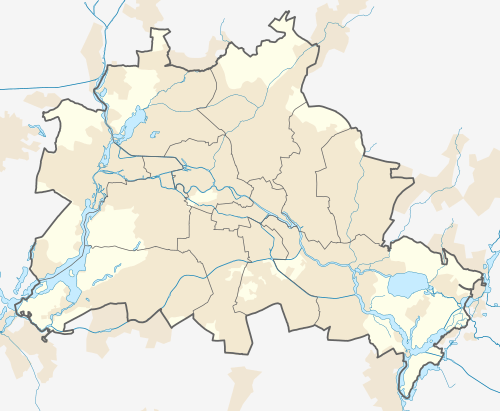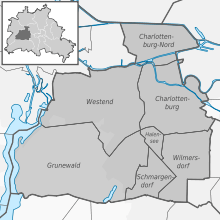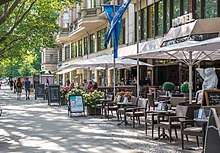Charlottenburg-Wilmersdorf
Charlottenburg-Wilmersdorf (German pronunciation: [ʃaʁˌlɔtn̩bʊʁk ˈvɪlmɐsdɔʁf]) is the fourth borough of Berlin, formed in an administrative reform with effect from 1 January 2001, by merging the former boroughs of Charlottenburg and Wilmersdorf.
Charlottenburg-Wilmersdorf | |
|---|---|
Borough of Berlin | |
 | |
 Coat of arms | |
Location of Charlottenburg-Wilmersdorf in Berlin .svg.png) | |
 Charlottenburg-Wilmersdorf  Charlottenburg-Wilmersdorf | |
| Coordinates: 52°30′N 13°17′E | |
| Country | Germany |
| State | Berlin |
| City | Berlin |
| Founded | 2001 |
| Subdivisions | 7 localities |
| Government | |
| • Mayor | Reinhard Naumann (SPD) |
| Area | |
| • Total | 64.72 km2 (24.99 sq mi) |
| Population (2012-12-31) | |
| • Total | 326,354 |
| • Density | 5,000/km2 (13,000/sq mi) |
| Time zone | CET/CEST (UTC+1/+2) |
| Postal codes | 10585, 10587, 10589, 10623, 10625, 10627, 10629, 10707, 10709, 10711, 10713, 10715, 10717, 10719, 10777, 13627, 14050, 14052, 14053, 14055, 14057, 14059, 14193, 14197, 14199 |
| Dialling codes | 030 |
| Vehicle registration | B |
| Website | Official homepage |
Overview
Charlottenburg-Wilmersdorf covers the western city centre of Berlin and the adjacent affluent suburbs. It borders on the Mitte borough in the east, on Tempelhof-Schöneberg in the southeast, Steglitz-Zehlendorf in the south, Spandau in the west and on Reinickendorf in the north. The district includes the inner city localities of Charlottenburg, Wilmersdorf and Halensee.
After World War II and the city's division by the Berlin Wall, the area around Kurfürstendamm and Bahnhof Zoo was the centre of former West Berlin, with the Kaiser Wilhelm Memorial Church as its landmark. The Technical University of Berlin (Technische Universität Berlin), the Berlin University of the Arts (Universität der Künste), the Federal Institute for Risk Assessment (Bundesinstitut für Risikobewertung), the Deutsche Oper Berlin as well as Charlottenburg Palace and the Olympic Stadium are also located in Charlottenburg-Wilmersdorf.
Demographics
As of 2012, the borough had a population of 326,354, of whom about 110,000 (34%) were of non-German origin. The largest ethnic minorities were Turks at 4%; Poles at 3.5%; Arabs, former Yugoslavians and Afro-Germans at 2.5% each; Russians at 1.5%; and Ukrainians and Iranians at 1.0% each.[1]
| Percentage of the population with migration background[2] | |
|---|---|
| Germans without migration background/Ethnic Germans | 66% (209,700) |
| Germans with migration background/Foreigners | 34 % (110,000) |
| - Middle Eastern/Muslim migration background (Turkey, Arab League, Iran etc.) | 8% (25,500) |
| - former Soviet background (Russia, Ukraine, Azerbaijan, Kazakhstan etc.) | 4.4% (14,000) |
| - Polish migration background | 3.5% (11,000) |
| - Yugoslavian migration background | 2.5% (7,500) |
| - Afro-German/African background | 2.5% (7,500) |
| - Others ( Greeks, Italians, East Asians etc.) | 13.1% (44,500) |
Subdivision
Charlottenburg-Wilmersdorf is divided into seven localities:

| Locality |
Area (km2) |
Inhabitants 31 December 2012 |
Density (inhabitants/km2) |
| 0401 Charlottenburg |
10.6 | 121,926 | 11,502 |
| 0402 Wilmersdorf |
7.16 | 95,164 | 13,291 |
| 0403 Schmargendorf |
3.59 | 20,476 | 5,704 |
| 0404 Grunewald |
22.3 | 11,703 | 525 |
| 0405 Westend |
13.5 | 38,944 | 2,885 |
| 0406 Charlottenburg-Nord |
6.2 | 73,057 | 11,783 |
| 0407 Halensee |
1.27 | 12,759 | 10,046 |
The localities of Schmargendorf and Grunewald were part of the former Wilmersdorf borough until 2001. By resolution of 30 September 2004, the localities of Westend and Charlottenburg-Nord were created on the territory of the former Charlottenburg borough, like Halensee on the territory of the former Wilmersdorf borough.
Politics
.svg.png)
Current allocation of seats in the borough's parliamentary body (Bezirksverordnetenversammlung) as of the 2016 Berlin state election:
- Social Democratic Party of Germany (SPD) 15
- Christian Democratic Union (CDU) 13
- Alliance '90/The Greens 12
- Free Democratic Party 6
- Alternative for Germany 5
- The Left 4
Twin towns — sister cities
The borough Charlottenburg-Wilmersdorf of Berlin is twinned with:[3]
- Twin towns of the former Charlottenburg borough
|
- Twin towns of the former Wilmersdorf borough
|
Economy

The borough's economy largely depends on retail trade, mainly in the City West area along Kurfürstendamm, Breitscheidplatz and Tauentzienstraße, with supra-local importance.
The Berliner Börse (Berlin Stock Exchange) is housed in the Ludwig-Erhard-Haus designed by Nicholas Grimshaw at Fasanenstraße 85 in Berlin-Charlottenburg near Bahnhof Zoologischer Garten
The Royal Porcelain Factory in Berlin (German: Königliche Porzellan-Manufaktur Berlin) (KPM) is also situated in Charlottenburg, near Berlin-Tiergarten Station
The Messe Berlin (Exhibition Grounds/Trade Fair Center) is situated in Berlin-Westend
Air Berlin had its headquarters in Building 2 of the Airport Bureau Center in Charlottenburg-Nord.[6][7] As of 2006 Air Berlin employed 1,200 employees at its headquarters.[8] Germania has its headquarters in Charlottenburg-Nord.[9]
Education
There are 74 schools in the city. There are 29,446 students attending these schools, 5,261 are foreigners.[10] Of the 12,993 students studies in 38 primary schools[11] while the number of students studying in the ymansiums is 9,617. In addition, there are 3 Hauptschule, 6 Realschule and 14 Gymnasium in the Charlottenburg-Wilmersdorf.
The district also has two universities, Technical University of Berlin[12] and Berlin University of the Arts.[13] In 2011, the Technical University of Berlin was named the 46th best university in the world in engineering and technology according to the QS World University Rankings.[14]
Higher education
- Universität der Künste (Berlin University of the Arts)
- Technische Universität Berlin (Technical University of Berlin)
- Bbw University of Applied Sciences
- ESCP Business School
- Touro College Berlin
Primary and secondary schools
- Comenius-Schule, a primary school, is in Wilmersdorf.[15]
- Halensee-Grundschule, a primary school, is in Halensee.[16]
- Jüdische Traditionsschule, traditionell Jewish primary and secondary school in Westend
- Heinz-Galinski-Schule Charlottenburg, Jewish primary school
- Svenska Skolan Berlin, Swedish School Berlin
- Nelson-Mandela-School, International School
- Goethe-Gymnasium, one of the most popular secondary schools in Berlin
- Peter-Ustinov-Schule, located between Messe Nord and Wilmersdorfer Straße.
- Evangelisches Gymnasium zum Grauen Kloster, School of the Evangelical Church
Weekend education
- The Japanische Ergänzungsschule in Berlin e.V. (ベルリン日本語補習授業校 Berurin Nihongo Hoshū Jugyō Kō), a weekend Japanese supplementary school, is held at Halensee-Grundschule.[17]
- Zentrale Schule für Japanisch Berlin e.V. (共益法人ベルリン中央学園補習授業校 Kyōeki Hōjin Berurin Chūō Gakuen Hoshū Jugyō Kō), another weekend Japanese supplementary school, is held at the Comenius-Schule[18] - Established April 1997.[19]
See also
- Berlin Charlottenburg – Wilmersdorf (electoral district)
- Berlin Spandau – Charlottenburg North (electoral district)
References
- http://www.statistik-berlin-brandenburg.de/Publikationen/Stat_Berichte/2011/SB_A1-5_hj01-11_BE.pdf
- http://www.statistik-berlin-brandenburg.de/Publikationen/Stat_Berichte/2011/SB_A1-5_hj02-10_BE.pdf
- "Partnerschaften" (in German). Bezirksamt Charlottenburg-Wilmersdorf von Berlin. Retrieved 2015-01-03.
- "Partner und Freundesstädte". Stadt Mannheim (in German). Retrieved 2013-07-26.
- "Gradovi prijatelji Splita" [Split Twin Towns]. Grad Split [Split Official City Website] (in Croatian). Archived from the original on 2012-03-24. Retrieved 2013-12-19.
- "Contact Archived 2010-03-16 at the Wayback Machine." Air Berlin. Retrieved on 12 May 2009.
- "Approach map Archived 2014-10-18 at the Wayback Machine." Air Berlin. Retrieved on 12 May 2009.
- Schulz, Stefan. "Ein Kandidat geht auf Tuchfühlung." Die Welt. 2 March 2006. Retrieved on 22 October 2009. "Am Saatwinkler Damm ist das Unternehmen mit 1200 Mitarbeitern (insgesamt 2700 Mitarbeiter) einer der größten Arbeitgeber der Hauptstadt."
- "Contact Archived 2010-04-18 at the Wayback Machine." Germania Airline. Retrieved on October 12, 2009.
- "Wayback Machine". web.archive.org. 2014-09-29. Retrieved 2020-01-15.
- "Wayback Machine". web.archive.org. 2013-11-23. Retrieved 2020-01-15.
- "TU Berlin: Kontakt". web.archive.org. 2015-04-29. Retrieved 2020-01-15.
- https://web.archive.org/web/20150808164546/http://www.arch.udk-berlin.de/
- http://www.topuniversities.com/university-rankings/world-university-rankings/2011/faculty-area-rankings/technology
- "Comenius-Schule." City of Berlin. Retrieved on April 6, 2015. "Comenius-Schule Gieselerstr. 4 10713 Berlin–Wilmersdorf"
- "Halensee-Grundschule." City of Berlin. Retrieved on April 2, 2015. "Halensee-Grundschule Joachim-Friedrich-Str. 35-36 10711 Berlin–Wilmersdorf"
- "2014 年度" (Archive). Japanische Erganzungsschule in Berlin. Retrieved on February 14, 2015. "Japanische Ergänzungsschule in Berlin e.V. c/o Halensee - Grundschule Joachim - Friedrich - Str. 35/36 10711 Berlin"
- "欧州の補習授業校一覧(平成25年4月15日現在" (). MEXT. Retrieved on May 10, 2014. "c/o Comenius-Schule Gieselerstr. 4, 10713 Berlin, GERMANY"
- "Deutsch." Zentrale Schule fur Japanisch Berlin e.V.. Retrieved on April 6, 2015. "Die Zentrale Schule für Japanisch Berlin e.V. wurde im April 1997 als gemeinnütziger Verein durch eine Elterninitiative gegründet, um Kindern und Jugendlichen aus japanischen, deutschen und interkulturellen Familien die Möglichkeit zu geben, ihre japanischen Sprachkenntnisse in Wort und Schrift zu erhalten und weiter zu entwickeln."
